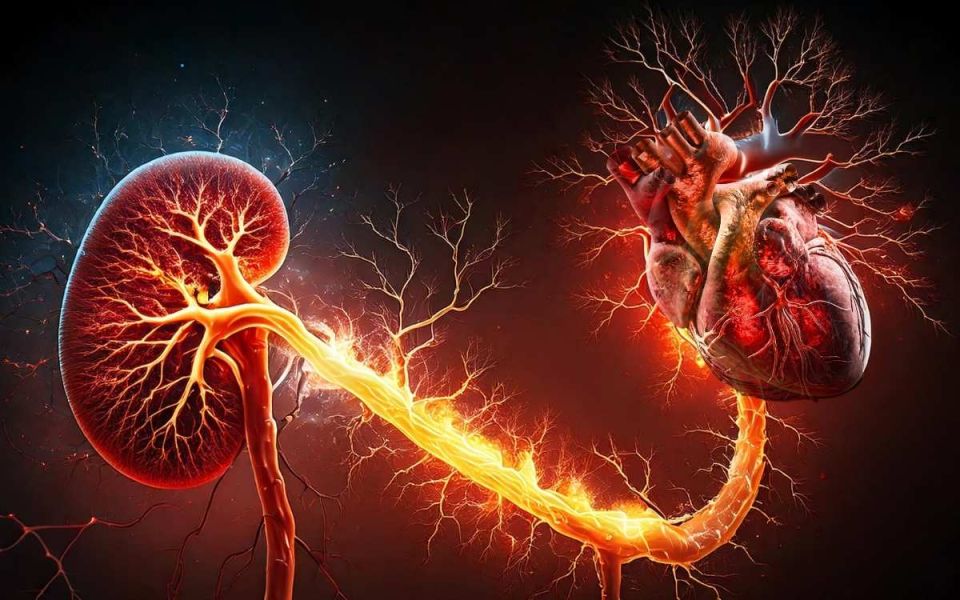Is Inflammation the Fire That Fuels Kidney and Heart Disease?

Inflammation is the body’s normal response to injury, infection, or harmful stimuli, aiming to protect and heal tissues. It’s like a campfire on a cool night - great for warmth, perfect for s’mores, and oddly hypnotic to stare at... until it decides to roast more than just marshmallows! When comparing inflammation and fire, the name, usefulness, and potential danger all bear a striking resemblance, and if you’re not careful, both could end up torching your tissues. Let’s try to shine a light on inflammation and how it might be the link between kidney disease and heart disease.
The kidneys are a pair of organs that filter our blood. When this filtration slows down or fails, we may have chronic kidney disease (CKD) - a condition that affects over 850 million people worldwide. CKD severity is classified according to a combination of the filtration rate and the amount of albumin - a protein - found in the urine. Lower filtration rates and more albumin indicate a higher risk of chronic kidney disease. This can be fatal on its own, but the cardiovascular system actually fails before the kidneys in most patients. Research shows that CKD is associated with increased risks of coronary artery disease, heart failure, high blood pressure, and sudden cardiac death. But why? Scientists think the link between kidney and cardiovascular disease may be inflammation. An acute inflammatory response helps protect us during trauma or infection, but chronic, lingering inflammation is a slow burn that can ultimately lead to widespread damage.
The kidneys influence inflammation in large part because they don’t just filter; they detect. The kidneys remove waste products, balance nutrients, help regulate blood pressure, and respond to things like dead cells. When the kidneys detect an imbalance in the system, they release proteins like hormones, cytokines, and enzymes. Hormones are chemical signal molecules, cytokines are immune regulatory proteins, and enzymes speed up chemical processes. These circulate through the bloodstream and help the body fend off whatever danger is present. In chronic kidney disease, however, the system breaks down.
When the kidneys aren’t functioning properly, they may mistakenly release proteins or release them in excess. Unfortunately, this fire burns at both ends because chronic inflammation is a major driver of kidney dysfunction. Kidneys and inflammation systems can undergo physical changes to cells or tissues that result in more hormone and cytokine release, more sensitivity to hormones and cytokines, or both. This is where it gets even more dangerous. Chronic inflammation affects the heart and blood vessels, but so do the kidneys. CKD and chronic inflammation can both raise blood pressure and increase the risk of atherosclerosis - plaques that harden the arteries. And, jumping from the frying pan to the fire, high blood pressure can damage the kidneys!
So what can be done? The first and most obvious things to target have clear solutions and quick effects, like quitting smoking and lowering high blood pressure. Unfortunately, the links between CKD and cardiovascular disease aren’t always managed properly. In fact, a 2015 research article1 found that patients with acute coronary syndrome and CKD were less likely to receive evidence-based therapies! This is despite several medications that have been shown to improve outcomes for these patients, including anti-inflammatory medications, statins, beta-blockers, ACE inhibitors, and more. One systemic problem has been the lack of inclusion of CKD patients in clinical trials that target cardiovascular diseases. However, this is starting to turn around, and clinical trials may be enrolling now that target this critical population. Let’s turn up the heat on inflammation and CKD to cook up some better solutions!
Check the research sites below or visit clinicaltrials.gov to see what research studies are available in your area.
Staff Writer / Editor Benton Lowey-Ball, BS, BFA
|
Click Below for ENCORE Research Group's Enrolling Studies |
|
Click Below for Flourish Research's Enrolling Studies |
References
Jankowski, J., Floege, J., Fliser, D., Böhm, M., & Marx, N. (2021). Cardiovascular disease in chronic kidney disease: pathophysiological insights and therapeutic options. Circulation, 143(11), 1157-1172. https://www.ahajournals.org/doi/10.1161/CIRCULATIONAHA.120.050686
Ridker, P. M., MacFadyen, J. G., Thuren, T., & Libby, P. (2020). Residual inflammatory risk associated with interleukin-18 and interleukin-6 after successful interleukin-1β inhibition with canakinumab: further rationale for the development of targeted anti-cytokine therapies for the treatment of atherothrombosis. European heart journal, 41(23), 2153-2163. https://pubmed.ncbi.nlm.nih.gov/31504417/
Stenvinkel, P. (2006). Inflammation in end‐stage renal disease: The hidden enemy. Nephrology, 11(1), 36-41. https://onlinelibrary.wiley.com/doi/abs/10.1111/j.1440-1797.2006.00541.x
Washam, J. B., Herzog, C. A., Beitelshees, A. L., Cohen, M. G., Henry, T. D., Kapur, N. K., ... & Newby, L. K. (2015). Pharmacotherapy in chronic kidney disease patients presenting with acute coronary syndrome: a scientific statement from the American Heart Association. Circulation, 131(12), 1123-1149. https://www.ahajournals.org/doi/full/10.1161/CIR.0000000000000183
Vidt, D. G. (2006). Inflammation in renal disease. The American journal of cardiology, 97(2), 20-27. https://doi.org/10.1016/j.amjcard.2005.11.012
Vilaysane, A., Chun, J., Seamone, M. E., Wang, W., Chin, R., Hirota, S., ... & Muruve, D. A. (2010). The NLRP3 inflammasome promotes renal inflammation and contributes to CKD. Journal of the American Society of Nephrology, 21(10), 1732-1744. https://pmc.ncbi.nlm.nih.gov/articles/PMC3013544/
Zoccali, C., & Mallamaci, F. (2023). Innate immunity system in patients with cardiovascular and kidney disease. Circulation research, 132(8), 915-932. https://www.ahajournals.org/doi/full/10.1161/CIRCRESAHA.122.321749



